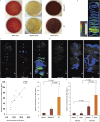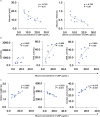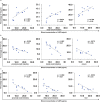Bacterial translocation aggravates CCl4-induced liver cirrhosis by regulating CD4+ T cells in rats
- PMID: 28134306
- PMCID: PMC5278361
- DOI: 10.1038/srep40516
Bacterial translocation aggravates CCl4-induced liver cirrhosis by regulating CD4+ T cells in rats
Abstract
Bacterial translocation (BT) is thought to play an important role in the development of liver cirrhosis, but the mechanisms have not been fully explored. This study aims to investigate the distribution of Treg (CD3+CD4+CD25+Foxp3+), Th17 (CD3+CD4+IL-17+), and Th1 (CD3+CD4+IFN-γ+) cells in the intestinal lamina propria, liver and blood and to explore their relationships with BT. Cirrhotic rats with ascites were induced by CCl4. We found that there were lower levels of total protein and albumin, lower albumin/globulin ratio, lower body weight and higher spleen weight and ascites volume in cirrhotic rats with than without BT. We found that BT may cause increase of Treg cells in the proximal small intestine and decrease of Th17 cells in the whole intestine and blood in cirrhotic rats. It may also aggravate the CCl4-induced decrease in Th1 cells in the whole intestine, liver, caecum, and blood and the CCl4-induced increase in Th17 cells in the liver and Tregs in the distal small intestine, colon, and liver. Our data suggest that BT may aggravate liver injury and decrease liver function via an interaction with CD4+ T Cells. The results of this study may be helpful for the development of new treatments for liver cirrhosis.
Conflict of interest statement
The authors declare no competing financial interests.
Figures





Similar articles
-
Effect of artesunate supplementation on bacterial translocation and dysbiosis of gut microbiota in rats with liver cirrhosis.World J Gastroenterol. 2016 Mar 14;22(10):2949-59. doi: 10.3748/wjg.v22.i10.2949. World J Gastroenterol. 2016. PMID: 26973391 Free PMC article.
-
Selective intestinal decontamination with norfloxacin enhances a regulatory T cell-mediated inflammatory control mechanism in cirrhosis.Liver Int. 2016 Dec;36(12):1811-1820. doi: 10.1111/liv.13172. Epub 2016 Jun 21. Liver Int. 2016. PMID: 27214392
-
Sodium selenite ameliorates dextran sulfate sodium-induced chronic colitis in mice by decreasing Th1, Th17, and γδT and increasing CD4(+)CD25(+) regulatory T-cell responses.World J Gastroenterol. 2017 Jun 7;23(21):3850-3863. doi: 10.3748/wjg.v23.i21.3850. World J Gastroenterol. 2017. PMID: 28638225 Free PMC article.
-
Effector and suppressor T cells in celiac disease.World J Gastroenterol. 2015 Jun 28;21(24):7349-56. doi: 10.3748/wjg.v21.i24.7349. World J Gastroenterol. 2015. PMID: 26139981 Free PMC article. Review.
-
Restoring homeostasis of CD4⁺ T cells in hepatitis-B-virus-related liver fibrosis.World J Gastroenterol. 2015 Oct 14;21(38):10721-31. doi: 10.3748/wjg.v21.i38.10721. World J Gastroenterol. 2015. PMID: 26478664 Free PMC article. Review.
Cited by
-
Resveratrol ameliorates liver fibrosis induced by nonpathogenic Staphylococcus in BALB/c mice through inhibiting its growth.Mol Med. 2022 May 4;28(1):52. doi: 10.1186/s10020-022-00463-y. Mol Med. 2022. PMID: 35508992 Free PMC article.
-
Enhanced efficacy of curcumin with phosphatidylserine-decorated nanoparticles in the treatment of hepatic fibrosis.Drug Deliv. 2018 Nov;25(1):1-11. doi: 10.1080/10717544.2017.1399301. Drug Deliv. 2018. PMID: 29214887 Free PMC article.
-
Intestinal Epithelial Chemokine (C-C Motif) Ligand 7 Overexpression Enhances Acetaminophen-Induced Hepatotoxicity in Mice.Am J Pathol. 2020 Jan;190(1):57-67. doi: 10.1016/j.ajpath.2019.09.009. Epub 2019 Oct 11. Am J Pathol. 2020. PMID: 31610172 Free PMC article.
-
Exploring the Relationship between Liver Disease, Bacterial Translocation, and Dysbiosis: Unveiling the Gut-Liver Axis.Visc Med. 2024 Feb;40(1):12-19. doi: 10.1159/000535962. Epub 2024 Jan 23. Visc Med. 2024. PMID: 38312368 Free PMC article. Review.
-
Recent insights into contributing factors in the pathogenesis of cirrhotic ascites.Front Med (Lausanne). 2024 Sep 13;11:1376217. doi: 10.3389/fmed.2024.1376217. eCollection 2024. Front Med (Lausanne). 2024. PMID: 39346937 Free PMC article. Review.
References
-
- Wiest R. & Garcia-Tsao G. Bacterial translocation (BT) in cirrhosis. Hepatology. 41, 422–433 (2005). - PubMed
-
- Garcia-Tsao G. & Wiest R. Gut microflora in the pathogenesis of the complications of cirrhosis. Best Pract. Res. Clin. Gastroenterol. 18, 353–372 (2004). - PubMed
-
- De Minicis S. et al.. Dysbiosis contributes to fibrogenesis in the course of chronic liver injury in mice. Hepatology. 59, 1738–1749 (2014). - PubMed
Publication types
MeSH terms
Substances
LinkOut - more resources
Full Text Sources
Other Literature Sources
Medical
Research Materials

